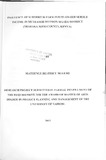| dc.description.abstract | Smallholder farmers are caught in the low productivity, low income vicious cycle resulting into food insecurity and poverty GOK (2007). The Kenya Government through the MoA has responded by providing the very resource farmers with subsidized farm inputs to enable the farm households to restart production and derive sufficient income. The study focused on assessing the influence of these subsidized farm inputs provided through NAAIAP programme using before-after programme approach on the household income and was guided by the following objectives; To find out how the type of subsidized farm inputs (planting, top dress fertilizer and certified maize seed) affect household income, determine whether, training on subsidized farm inputs affect household income, examine how the criteria used to select beneficiaries of subsidized farm inputs influence household income, establish whether the time when subsidized farm inputs affect household income.
Literature review on the four objectives was discussed and their influence on household income and gaps on knowledge of whether the interventions have an impact on the household well being identified. The respondents were selected purposively using stratified random sampling method from Gitije, Mitheru, Muthambi and Karimba locations in Muthambi division and 200 respondents selected as the sample size. Data was collected using questionnaires, documentary analysis, interview and observation research instruments. Data was analyzed using Statistical Package of Social Scientists (SPSS) and presented in form of tables and percentages.
There was no direct link between the subsidy and income and instead, a three stage model was used by first estimating the productivity, then output and finally incomes to the respondents and from the findings, it was concluded that iirrespective of the amount of subsidized fertilizers and maize seeds received there was an increase in the income generated from maize farming compared to previous year as a result of the inputs given. Further the criteria used to select subsidized farm inputs beneficiaries (vulnerability, land size and age) are not feasible for determination of the income of a household as a result of subsidized farm inputs. The time factor of when the inputs were supplied had an effect on the eventual income of the house hold. On the other hand training content had a positive effect on the income of the house hold income and thus no relationship of the training approach used on the house hold income. | en_US |

